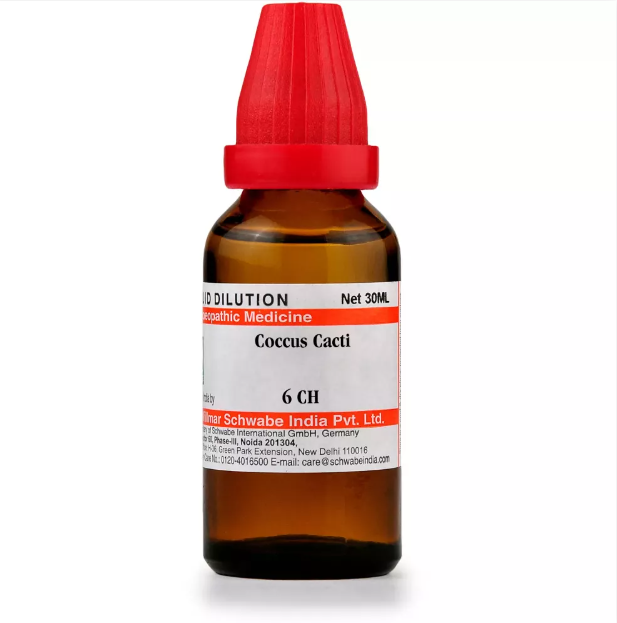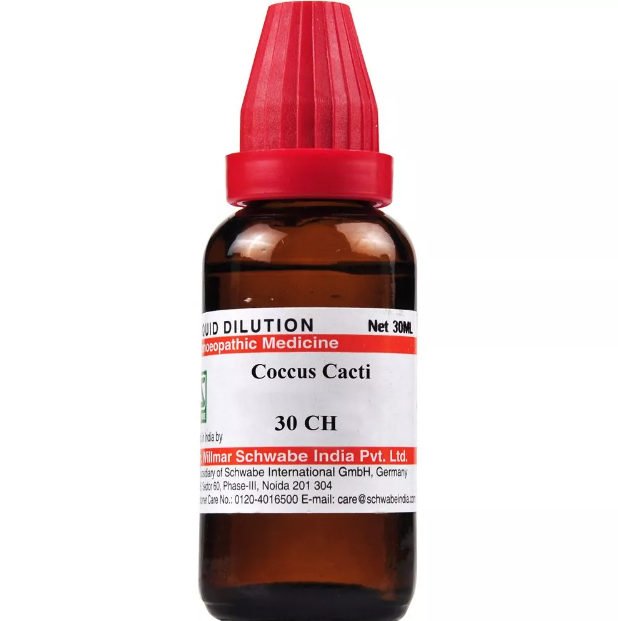COCCUS CACTI Q, 6C, 12C, 30C, 200C, 1M, 10M USES AND SYMPTOMS
 COCCUS CACTI
COCCUS CACTI
Coc-c.
This remedy is used for spasmodic and whooping coughs and bladder catarrhal conditions; spasmodic kidney pains (nephritis) with visceral tenesmus (cystitis). It treats anuria, anasarca, and ascites.
Mind: Sadness in the morning or afternoon.
Head: Suboccipital soreness, worse after sleep and exertion. Headache improves with head elevated, worsens when lying on the back.
Eyes: Dull pain over the right eye in the morning. Sensation of a foreign body between upper lid and eyeball. Distress from cinders in the eye.
Urinary: Urgency to urinate; brick-red sediment. Urinary calculi, hematuria, urates, and uric acid; sharp pains from kidney to bladder. Deep-colored, thick urine (gonorrhea). Dysuria.
Female: Early, profuse, black, and thick menses (menorrhagia); dark clots with dysuria. Intermittent menstruation (metrorrhagia); flow only in the evening and at night. Large clots escape during urination. Inflamed labia.
Respiratory: Constant hawking from an enlarged uvula; coryza with inflamed throat; thick, sticky mucus that is hard to expectorate. Tickling in the larynx. Sensation of a crumb behind the larynx, requiring continuous swallowing; brushing teeth causes cough. Sensitive fauces. Suffocative cough, worse on waking, with tough, white mucus that strangles (asthma). Spasmodic morning cough. Whooping cough ends with vomiting of tough mucus. Chronic bronchitis with gravel; large amounts of tenacious mucus are expectorated. Walking against the wind causes breathlessness.
Heart: Sensation of pressure towards the heart.
Modalities: Worse on the left side, after sleep, touch, pressure of clothing, brushing teeth, slightest exertion. Better when walking.
Relationship: Compare with Canth., Cact., Sars.
SYMPTOMS OF COCCUS CACTI
Mind:
Sadness in the morning or afternoon.
Head:
Suboccipital soreness, worse after sleep and exertion.
Headache, improves with head elevated, worsens when lying on the back.
Eyes:
Dull pain over the right eye in the morning.
Sensation of a foreign body between upper lid and eyeball.
Distress from cinders in the eye.
Urinary:
Urgency to urinate; brick-red sediment.
Urinary calculi, hematuria, urates, and uric acid.
Sharp pains from kidney to bladder.
Deep-colored, thick urine (gonorrhea).
Dysuria.
Female:
Early, profuse, black, and thick menses (menorrhagia).
Dark clots with dysuria.
Intermittent menstruation (metrorrhagia), flow only in the evening and at night.
Large clots escape during urination.
Inflamed labia.
Respiratory:
Constant hawking from an enlarged uvula.
Coryza with inflamed throat.
Thick, sticky mucus that is hard to expectorate.
Tickling in the larynx.
Sensation of a crumb behind the larynx, requiring continuous swallowing.
Brushing teeth causes cough.
Sensitive fauces.
Suffocative cough, worse on waking, with tough, white mucus that strangles (asthma).
Spasmodic morning cough.
Whooping cough ends with vomiting of tough mucus.
Chronic bronchitis with gravel; large amounts of tenacious mucus are expectorated.
Walking against the wind causes breathlessness.
Heart:
Sensation of pressure towards the heart.
Modalities:
Worse on the left side, after sleep, touch, pressure of clothing, brushing teeth, slightest exertion.
Better when walking.
selection of the potency
Individualization:
- Homeopathy is based on the principle of treating the individual, not just the disease. The unique symptoms and characteristics of the person are crucial in determining the most suitable potency.
Intensity of Symptoms:
- The intensity of the symptoms guides the choice of potency. If the symptoms are intense and acute, a lower potency (e.g., 6C, 30C) might be considered. For chronic conditions with less intensity, higher potencies (e.g., 200C, 1M) may be appropriate.
Sensitivity of the Patient:
- Some individuals are more sensitive to homeopathic remedies, while others may require higher potencies. The practitioner considers the patient’s sensitivity when selecting the potency.
Acute vs. Chronic Conditions:
- Lower potencies are often used for acute conditions, while higher potencies may be considered for chronic or long-standing issues.
Previous Response to Potencies:
- The patient’s response to previous homeopathic treatments helps guide the choice of potency. If a particular potency has been effective in the past, it may be repeated or adjusted as needed.
Vital Force and Susceptibility:
- Homeopathy views illness as a disturbance in the vital force. The practitioner assesses the patient’s overall vitality and susceptibility to determine the appropriate potency.
Aggravation or Amelioration:
- The direction of the symptom response (aggravation or amelioration) after taking a remedy can influence the choice of potency.
Miasmatic Considerations:
- In classical homeopathy, the concept of miasms (inherited disease tendencies) is considered. The practitioner take this into account when selecting the potency.
Practitioner Experience:
- The experience and preference of the homeopathic practitioner play a role. Some practitioners may have success with certain potencies based on their clinical experience.
SAFETY INFORMATION
- Do not exceed the recommended dose by physician
- Keep out of the reach of children
- Store in a cool dry place away from direct sunlight
- Maintain half an hour gap between food/drink/any other medicines and homoeopathic medicine
- Avoid any strong smell in the mouth while taking medicine e.g. camphor, garlic, onion, coffee, hing
Medicine images use for reference only selection of homeopathic medicine depends on the individual’s specific symptoms and overall constitution. Moreover, homeopathy is a holistic system of medicine that treats the individual as a whole. In addition to addressing the physical symptoms, it takes into account the emotional and mental state of the person. Consequently, it’s crucial to consult with a qualified homeopathic practitioner for personalized treatment.
The information provided on this website is intended solely for educational purposes. Always seek the advice of your physician or other qualified health provider.
